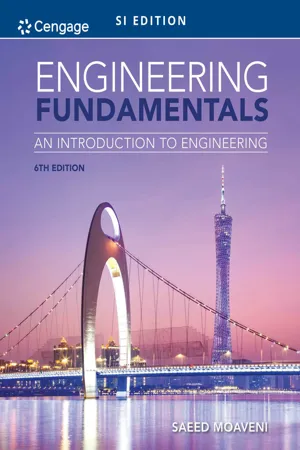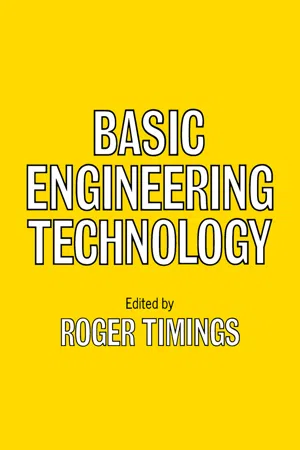Technology & Engineering
Engineering Graphs
Engineering graphs are visual representations used by engineers to analyze and communicate data, relationships, and designs. They can include various types such as line graphs, bar graphs, and pie charts, and are often used to illustrate trends, comparisons, and patterns in engineering processes and systems. These graphs are essential tools for decision-making, problem-solving, and conveying complex information in a clear and concise manner.
Written by Perlego with AI-assistance
Related key terms
1 of 5
7 Key excerpts on "Engineering Graphs"
- Dennis Lieu, Sheryl Sorby(Authors)
- 2016(Publication Date)
- Cengage Learning EMEA(Publisher)
Second, engineering graphics has served as a means of recording the history of an idea and its development over time. As designs became more complex, it became necessary to record the ideas or features that worked well in a design so they could be repeated in future applications. And third, engineering graphics has served as a tool for analysis to determine critical shapes and sizes, as well as other variables needed in an engineered system. These three roles are still vital today, more so than in the past, because of the tech-nical complexity required in making modern products. Computers, three-dimensional modeling, and graphics software have made it increasingly effective to use engineering graphics as an aid in design, visualization, and optimization. 1.01 I N T R O D U C T I O N A Short History The way things are done today evolved from the way things were done in the past. You can understand the way engineering graphics is used today by examining how it was used in the past. Graphical communications has supported engineering throughout history. The nature of engineering graphics has changed with the development of new graphics tools and techniques. 1.02 Copyright 2017 Cengage Learning. All Rights Reserved. May not be copied, scanned, or duplicated, in whole or in part. Due to electronic rights, some third party content may be suppressed from the eBook and/or eChapter(s). Editorial review has deemed that any suppressed content does not materially affect the overall learning experience. Cengage Learning reserves the right to remove additional content at any time if subsequent rights restrictions require it. 1-4 section one Laying the Foundation Ancient History The earliest documented forms of graphical communication are cave paintings, such as the one shown in Figure 1.01, which showed human beings depicting organized social behavior, such as living and hunting in groups.- eBook - PDF
Engineering Fundamentals
An Introduction to Engineering, SI Edition
- Saeed Moaveni(Author)
- 2019(Publication Date)
- Cengage Learning EMEA(Publisher)
3DDock/Shutterstock.com Engineering Graphical Communication Conveying Information to Other Engineers, Machinists, Technicians, and Managers Copyright 2020 Cengage Learning. All Rights Reserved. May not be copied, scanned, or duplicated, in whole or in part. Due to electronic rights, some third party content may be suppressed from the eBook and/or eChapter(s). Editorial review has deemed that any suppressed content does not materially affect the overall learning experience. Cengage Learning reserves the right to remove additional content at any time if subsequent rights restrictions require it. 637 E ngineers use technical drawings to convey useful information to others in a stan- dard manner. An engineering drawing provides information, such as the shape of a product, its dimensions, materials from which to fabricate the product, and assembly steps. Some engineering drawings are specific to a particular discipline. For example, civil engineers deal with land or boundary, topographic, construction, and route survey drawings. Electrical and electronic engineers, on the other hand, deal with printed circuit-board assembly drawings, printed circuit-board drill plans, and wiring diagrams. Engineers also use special symbols and signs to convey their ideas, and show analyses and solutions to problems. In Part Four of this book, we will intro- duce you to the principles and rules of engineering graphical communication and engineering symbols. A good grasp of these principles will enable you to convey and understand information effectively. P A R T 4 CHAPTER 16 Engineering Drawings and Symbols Copyright 2020 Cengage Learning. All Rights Reserved. May not be copied, scanned, or duplicated, in whole or in part. Due to electronic rights, some third party content may be suppressed from the eBook and/or eChapter(s). Editorial review has deemed that any suppressed content does not materially affect the overall learning experience. - eBook - ePub
Engineering GNVQ
Intermediate
- Mike Tooley(Author)
- 2012(Publication Date)
- Routledge(Publisher)
Having now established the need for communicating engineering information, let's look at the various methods of graphical communication available. We can broadly divide engineering information into two categories: that which is mathematically based, and that which is technically based. Let's be logical and look at the former first.Mathematical data
I expect that you will already have met most of the methods of expressing mathematical data by means of graphs. Nevertheless, let's revise the techniques available.Line graphs
Just as engineering drawings are used as a clear and convenient way of describing complex components and assemblies, so can graphs be used to give a clear and convenient picture of the mathematical relationships between engineering and scientific quantities. Figure 1.4 (a) shows a graph of the relationship between distance S and time t for the mathematical expression S = ½ a t2 where the acceleration a = 10 m/s2 .In this instance it is correct to use a continuous curve to connect the points plotted. Not only do these points lie on the curve, but every corresponding value of S and t between the points plotted also lie on the curve.However, this is not true for every type of line graph. Figure 1.4 (b) shows a graph relating speed and distance for a journey. From A to B the vehicle is accelerating. From B to C the vehicle is travelling at a constant speed. From C to D the vehicle is decelerating (slowing down). In this example it is correct to join the points by straight lines This is because each stage of the journey is represented by a linear mathematical expression which is unrelated to the previous stage of the journey and unrelated to the following stage of the journey.Histograms
Consider the student intake of a college over a number of years. The students enrol in September and leave in the following July. Between these times there is a negligible change in the number of students attending. Therefore to plot the enrolments for each September and connect these by a flowing curve between the points would be incorrect. Such graphs would imply that there is a continuous change in student numbers between one September and the next and that the change satisfies a mathematical equation. - eBook - PDF
- Lokesh Pandey(Author)
- 2023(Publication Date)
- Arcler Press(Publisher)
To guarantee accuracy and completeness, requirements must be developed with considerable care. These papers are often included in engineering agreements and can be used to record design specifics (Feeney & Price, 2000). As a result, the terminology used in such papers is exact, and the style of writing is judicial. Figure 6.4 depicts an illustration of certain technical standards. Engineering Communications 177 6.4. GRAPHICAL COMMUNICATIONS The majority of engineers interact with one another and with other professionals using a world language of technical visualization tools. Hand drawings to extremely complex computer-produced representations and models are all examples of such expressions. The drawings and computer- generated images transcend culture and traditions (Flater & Morris, 2001; Patil et al., 2002). Figure 6.4. Illustration of engineering specs. Source: https://www.academia.edu/30141729/_Paul_H_Wright_Introduction_ to_engineering_BookZZ_org_. Scientific Principles of Engineering 178 They are specially designed to eliminate misunderstanding by precisely describing construction and production specifics. Every one of these depictions is constructed utilizing industry-adopted standards and nomenclature, which become communication standards utilized in both hand-made messages and computer processor forms (Thornton & Huang, 2013; Bailey, 1974). Several of the presentations are specified by groups like ANSI as well as ASME. As an artist, you should be able to develop these forms to explain your work as well as process and comprehend graphical presentations created by others. You might well be requested to generate a cost estimate for building or producing the things indicated in the graphic renderings, or you’d be explaining the planning of a project to a field supervisor who might make the artifact specified in a design (Blackman & Tukey, 1958). The level of information in such depictions often differs depending on the target audience. - eBook - ePub
Sojourning in Disciplinary Cultures
A Case Study of Teaching Writing in Engineering
- Maureen Mathison(Author)
- 2019(Publication Date)
- Utah State University Press(Publisher)
common graphical choice (70% of papers) was a diagram or schematic possibly the most widely used type of graphic in mechanical engineering. By way of comparison, 57 percent of papers included a data table or data graphic, and 43 percent included an illustration. Since the vast majority of reports in the study corpus explored or advocated for the continuing research and development of specific technologies, it is appropriate that writers would include graphical elements that describe the mechanics or processes involved in the technology being discussed. The remaining discussion in this study will analyze writers’ rhetorical use of these three groupings within the study corpus: diagrams and schematics, data tables and data graphics, and illustrations.Diagrams and Schematics
Diagrams and schematics depict processes via abstractions of system flows, and labeling that stresses the working of components within a system. Whether making a claim or not, writers typically included a diagram or schematic of the working process of the primary technology being discussed in the report, for example, a dry steam power plant, a solar cell, a wave terminator, a fuel cell, a wastewater treatment plant, or a septic tank. As such, the diagrams and schematics were often included near the beginning of the body of the paper as an overview to the topic. As one of the key graphical types used in engineering design, it makes intuitive sense that even without instruction, students have accurate ideas about the use of diagrams and schematics, picked up from their information environment. This may also be indicative of engineering students’ “information ground” (Pettigrew 1999).While writers typically used diagrams and schematics that accurately matched the device or system being described in the report, they also typically assumed these diagrams and schematics were self-explanatory, including little metadiscourse about them, leaving the reader without much interpretative focus (Mathison, previous chapter). Additionally, because the diagrams and schematics were being lifted from other sources rather than created by the students themselves, the graphics often included much more information than was discussed within the text of the students’ reports. At times, this incongruence between graphic and text raised questions about whether the writer’s discussion was accurate and thorough. At other times, the writer’s terminology did not match the labeling of the graphic, causing confusion for readers. For example, one student wrote, “A terminator is a device that can absorbs, transmits and reflects all the energy in a wave [sic - eBook - PDF
- R L Timings(Author)
- 2014(Publication Date)
- Butterworth-Heinemann(Publisher)
British Standard specifications are issued in booklets. Electrical installation engineers will con-stantly refer to the 'Regulations for the electrical equipment of buildings' published by the Institu-tion of Electrical Engineers (the IEE Regula-tions). Many tables of data are collected together and published in book form. Graphs Line graphs Just as engineering drawings are used as a clear and convenient way of describing complex products, so can graphs be used to give a clear and convenient description of numerical and mathematical data. Figure 9.2a shows a graph of the relationship between distance s and time t for the mathematical expression s = α?Ι2 when the acceleration a is 10 m/s 2 . In this instance it is correct to use a continuous flowing curve connec-ting the points plotted, since not only do these points lie on the curve, but every corresponding value of t and s between the points plotted also lies on the curve. However, this is not true for every type of graphical representation. Figure 9.2b shows a graph relating velocity and time. From A 3000 'Ϊ 2000 1 0 0 0 L 0 1984 1985 1986 1987 College year Figure 9.3 Histogram 1988 INTERPRETING DRAWINGS, SPECIFICATIONS AND DATA 153 Job no. nu m 1 5 10 15 20 25 30 June 1988 (working days) Figure 9.4 Bar progress chart to B the object is accelerating; from B to C it is travelling with constant velocity; and from C to D it is decelerating (slowing down). In this example it is correct to connect the points with straight lines, since each stage of the journey is represented by a linear expression which is unrelated to the preced-ing or to the following stage of the journey. Histograms Consider the student intake of a college over a number of years. The students enrol in September and leave in July. Between these months there is negligible change in the number of students attending. - eBook - PDF
- Mike Tooley, Lloyd Dingle(Authors)
- 2010(Publication Date)
- Routledge(Publisher)
Activity 2.11 If you have not already done so, set up a web-based e-mail account in your own name. Note down all of the steps that you took to open the account including details of any electronic forms that you had to complete. Present your findings in the form of a brief word processed article for your local paper showing how easy it is to open and make use of an e-mail account. You should assume that the reader is non-technical. Communications for Engineering Technicians 86 UNIT 2 Presenting Engineering Information Engineers rely heavily upon graphical methods of communication. Drawings and charts produced to international standards and using international symbols and conventions suffer no language barriers. They are not liable to be misinterpreted by translation errors. Graphical communication does not replace spoken and written communication but instead is used to simplify, reinforce and complement other means of communication. Having now established the need for communicating engineering information, let us look at the various methods of graphical communication available. We can broadly divide engineering information into two categories. That which is mathematically based and that which is technically based. We will start by looking at ways of representing mathematical data. Graphs Just as engineering drawings are used as a clear and convenient way of describing complex components and assemblies, so can graphs be used to give a clear and convenient picture of the mathematical relationships between engineering and scientific quantities. Figure 2.14a shows a graph of the relationship between distance s and time t for the mathematical expression s ½ at 2 , where the acceleration a 10 m s 1 . 200 150 100 Distance, s (m) 50 0 1 2 3 4 Time, t (s) s 12 at 2 when a 10 m/s 2 5 6 0 B C D A Acceleration Deceleration Constant velocity Velocity (m/s) Time (s) (a) (b) Figure 2.14 Line graphs
Index pages curate the most relevant extracts from our library of academic textbooks. They’ve been created using an in-house natural language model (NLM), each adding context and meaning to key research topics.






